How to Make Repetitive Tasks Enjoyable in ELT Primary Classrooms: Reflection-for-Action
Without a doubt, repetition is essential for young learners to improve both fluency and accuracy, but it can quickly become stale if not approached creatively. As primary English language teaching (ELT) educators, finding the balance between repetitive tasks (or activities) and introducing new ones can be a fun challenge, especially when you want to maintain similar levels of engagement.
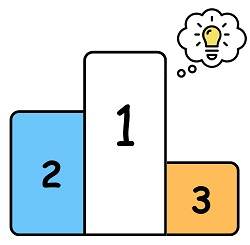 Take a moment to reflect on the types of activities you and your students enjoy together in the classroom. These activities should be stimulating and motivating. What strategies do you employ to keep these activities interesting? How do your students respond to them each time?
Take a moment to reflect on the types of activities you and your students enjoy together in the classroom. These activities should be stimulating and motivating. What strategies do you employ to keep these activities interesting? How do your students respond to them each time?
As you reflect, I would like to share three strategies in this blog that incorporate both gamification and reflective practices. Game-like elements help turn activities into fun, motivating experiences, while reflection allows students to tune into their own learning. Each strategy encourages at least two of the following forms of reflective practice:
Reflection-in-action: The ability to reflect while doing something. For example, learners might stop and think, “How can I use this word correctly in my sentence?”
Reflection-on-action: The practice of reviewing a situation or event after it has happened. Someone might say something along the lines of, “I did well using different adjectives, but I want to answer the questions more quickly next time.”
Reflection-for-action: The thought of future actions with intention to improve or change a practice in general. Learners could think, “Next time, I’ll focus on using more adjectives in my sentences.”
1. Introduce Different Rounds of an Activity for Interest
Delivering a short, five-to-ten-minute language activity in a series of rounds can help learners focus more on their progress rather than relying solely on repetition. The addition of extra rounds, time pressure, and possible points for correct answers can transform any language-focused activity into a friendly, fun competition — for students to compete both against their own personal best and their peers.
For example, let’s say a group of primary students have been learning how to write sentences with different prepositions in English. The activity could be structured in rounds like this:
-
- Round 1: Write two sentences using two prepositions each in five minutes.
- Round 2: Write five sentences using two prepositions each in ten minutes.
- Round 3: Write one sentence using three prepositions in one minute.
In between rounds, consider including reflective prompts, such as “how did it go?” Or even, “what would you like to improve on in the next round?” These prompts will not only encourage you to adjust the tasks for students but also provide students with the opportunities to reflect both while they are writing (reflection-in-action), and after they finish (reflection-on-action).
2. Alter Activity Conditions for Added Variety
Changing the conditions of the activity is almost like modifying the settings of a game. By introducing variations related to more or fewer team members, or new challenges each time, you can keep the same activity dynamic and engaging. These slight changes — made each time you play — provide scaffolding that helps sustain learners’ focus.
A simple yet consistent way to adjust the levels of difficulty is to create a table either to be displayed in the classroom or recorded in a folder. This table can be accessed before, during, or even after the activity for next time, depending on your preferences and students’ needs. A table of reference could look like this:
|
|
Easy |
Difficult |
|
Duration |
Increase amount of time to complete activity slowly with accuracy. |
Reduce amount of time to complete activity quickly with accuracy. |
|
Participatory Levels |
Encourage pair work or groupwork for collaboration with teacher assistance. |
Encourage individual work without teacher or peer assistance. |
|
Task Requirements |
Reduce number of steps required to use specific language forms. |
Increase number of steps to encourage applying a range of language forms. |
While the records of activity conditions could be organized like this teacher's edition:
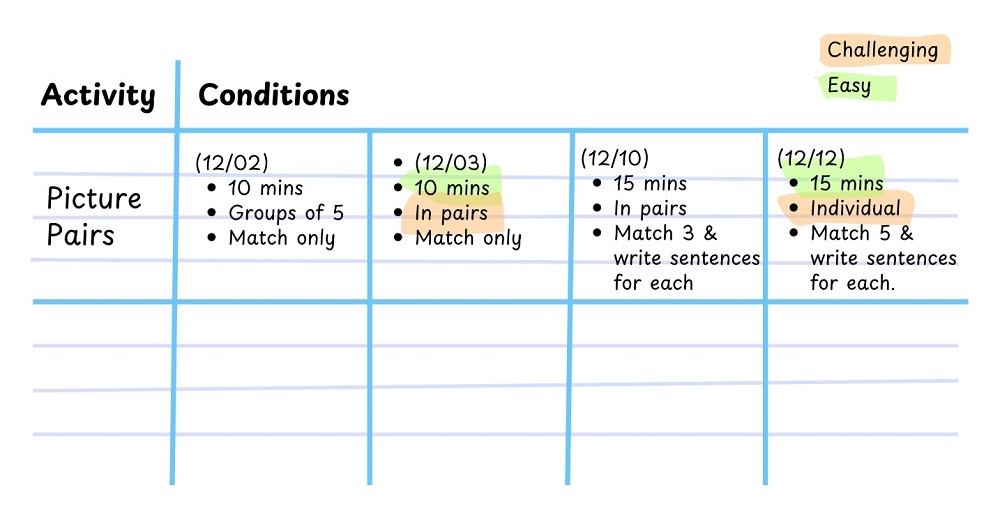
Students can also feel more involved with the learning process if they can occasionally help with deciding whether the level of difficulty should be increased or decreased. The extra minute or two discussing the task changes as a class — regardless of whether it’s a teacher or class decision — can activate both reflection-in-action and reflection-for-action simultaneously to help develop self-efficiency.
3. Create an Activity Log for Progress
Tracking progress can be a motivating way for younger learners to stay engaged in repeated activities. There are several ways to help students reflect on learning by creating an activity log.
One simple approach is to use a tally chart at the back of a notebook, where students record the name of each activity in the margin, like this example with tally charts for two repetitive activities:
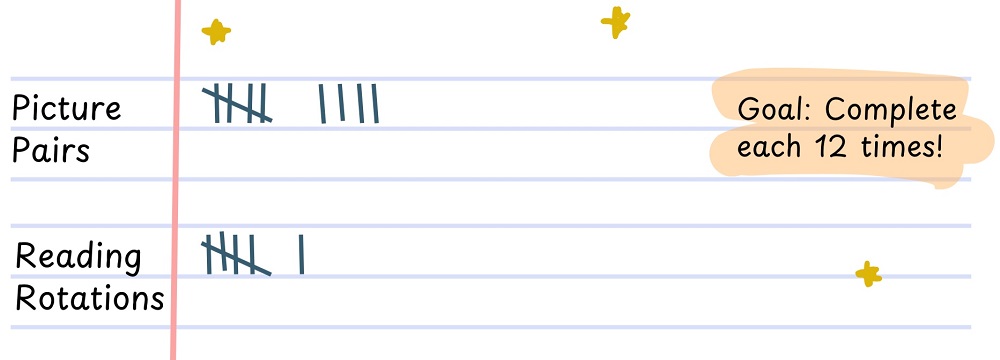
Another option is to create a printed table with a series of columns and rows for students to fill in with points or scores. This can also give students instant feedback on their current progress. To make it more personal, students can decorate their tables as they wish. Here is an example of how the table might look as a printed handout that students fill in:
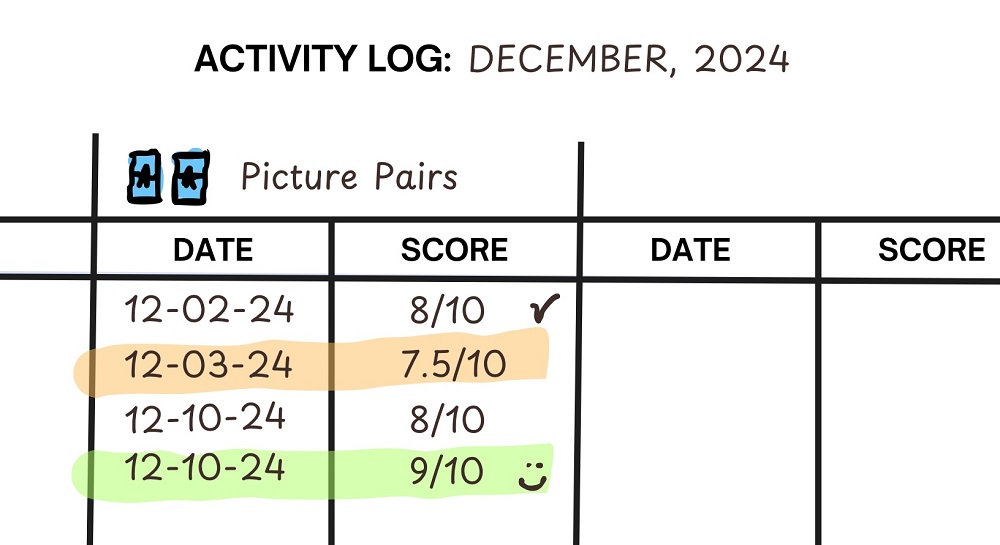
If the goal is to encourage students to reflect on their mood or emotion after the activity, students could draw an emoji on the bottom corner of their notebook at the end of each session (see image, right). Over time, this creates a mini flip book effect!
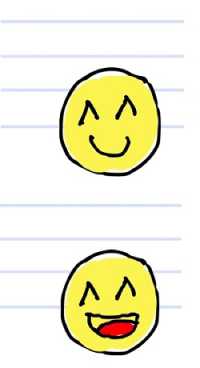 The emojis can serve as a fun reward for students to enjoy as they reflect on their progress. Some students may prefer dedicating a full page to their emojis, so offering options can help motivate them to stay engaged.
The emojis can serve as a fun reward for students to enjoy as they reflect on their progress. Some students may prefer dedicating a full page to their emojis, so offering options can help motivate them to stay engaged.
At the end of the day, there are countless ways to transform repetitive language activities into fun, game-like experiences. I hope these strategies inspire you to build on or expand your own teaching practices. At the end of the day, taking just a minute or two for students to reflect on their feelings and progress after each session can make any activity feel enjoyable and engaging, keeping them eager to continue learning.
 Happy Teaching and Learning!
Happy Teaching and Learning!

